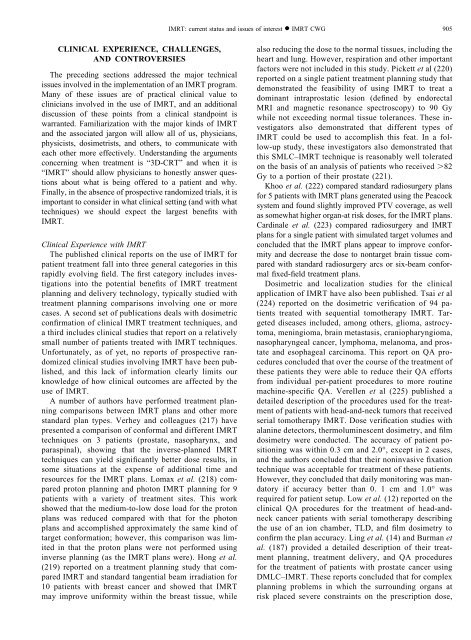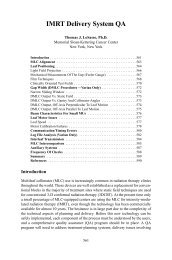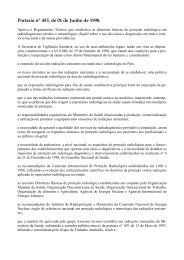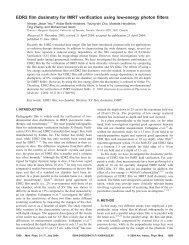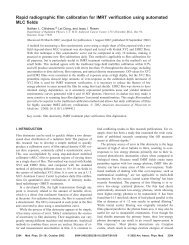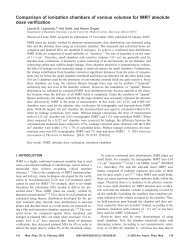intensity-modulated radiotherapy: current status and issues
intensity-modulated radiotherapy: current status and issues
intensity-modulated radiotherapy: current status and issues
Create successful ePaper yourself
Turn your PDF publications into a flip-book with our unique Google optimized e-Paper software.
IMRT: <strong>current</strong> <strong>status</strong> <strong>and</strong> <strong>issues</strong> of interest ● IMRT CWG<br />
905<br />
CLINICAL EXPERIENCE, CHALLENGES,<br />
AND CONTROVERSIES<br />
The preceding sections addressed the major technical<br />
<strong>issues</strong> involved in the implementation of an IMRT program.<br />
Many of these <strong>issues</strong> are of practical clinical value to<br />
clinicians involved in the use of IMRT, <strong>and</strong> an additional<br />
discussion of these points from a clinical st<strong>and</strong>point is<br />
warranted. Familiarization with the major kinds of IMRT<br />
<strong>and</strong> the associated jargon will allow all of us, physicians,<br />
physicists, dosimetrists, <strong>and</strong> others, to communicate with<br />
each other more effectively. Underst<strong>and</strong>ing the arguments<br />
concerning when treatment is “3D-CRT” <strong>and</strong> when it is<br />
“IMRT” should allow physicians to honestly answer questions<br />
about what is being offered to a patient <strong>and</strong> why.<br />
Finally, in the absence of prospective r<strong>and</strong>omized trials, it is<br />
important to consider in what clinical setting (<strong>and</strong> with what<br />
techniques) we should expect the largest benefits with<br />
IMRT.<br />
Clinical Experience with IMRT<br />
The published clinical reports on the use of IMRT for<br />
patient treatment fall into three general categories in this<br />
rapidly evolving field. The first category includes investigations<br />
into the potential benefits of IMRT treatment<br />
planning <strong>and</strong> delivery technology, typically studied with<br />
treatment planning comparisons involving one or more<br />
cases. A second set of publications deals with dosimetric<br />
confirmation of clinical IMRT treatment techniques, <strong>and</strong><br />
a third includes clinical studies that report on a relatively<br />
small number of patients treated with IMRT techniques.<br />
Unfortunately, as of yet, no reports of prospective r<strong>and</strong>omized<br />
clinical studies involving IMRT have been published,<br />
<strong>and</strong> this lack of information clearly limits our<br />
knowledge of how clinical outcomes are affected by the<br />
use of IMRT.<br />
A number of authors have performed treatment planning<br />
comparisons between IMRT plans <strong>and</strong> other more<br />
st<strong>and</strong>ard plan types. Verhey <strong>and</strong> colleagues (217) have<br />
presented a comparison of conformal <strong>and</strong> different IMRT<br />
techniques on 3 patients (prostate, nasopharynx, <strong>and</strong><br />
paraspinal), showing that the inverse-planned IMRT<br />
techniques can yield significantly better dose results, in<br />
some situations at the expense of additional time <strong>and</strong><br />
resources for the IMRT plans. Lomax et al. (218) compared<br />
proton planning <strong>and</strong> photon IMRT planning for 9<br />
patients with a variety of treatment sites. This work<br />
showed that the medium-to-low dose load for the proton<br />
plans was reduced compared with that for the photon<br />
plans <strong>and</strong> accomplished approximately the same kind of<br />
target conformation; however, this comparison was limited<br />
in that the proton plans were not performed using<br />
inverse planning (as the IMRT plans were). Hong et al.<br />
(219) reported on a treatment planning study that compared<br />
IMRT <strong>and</strong> st<strong>and</strong>ard tangential beam irradiation for<br />
10 patients with breast cancer <strong>and</strong> showed that IMRT<br />
may improve uniformity within the breast tissue, while<br />
also reducing the dose to the normal t<strong>issues</strong>, including the<br />
heart <strong>and</strong> lung. However, respiration <strong>and</strong> other important<br />
factors were not included in this study. Pickett et al (220)<br />
reported on a single patient treatment planning study that<br />
demonstrated the feasibility of using IMRT to treat a<br />
dominant intraprostatic lesion (defined by endorectal<br />
MRI <strong>and</strong> magnetic resonance spectroscopy) to 90 Gy<br />
while not exceeding normal tissue tolerances. These investigators<br />
also demonstrated that different types of<br />
IMRT could be used to accomplish this feat. In a follow-up<br />
study, these investigators also demonstrated that<br />
this SMLC–IMRT technique is reasonably well tolerated<br />
on the basis of an analysis of patients who received 82<br />
Gy to a portion of their prostate (221).<br />
Khoo et al. (222) compared st<strong>and</strong>ard radiosurgery plans<br />
for 5 patients with IMRT plans generated using the Peacock<br />
system <strong>and</strong> found slightly improved PTV coverage, as well<br />
as somewhat higher organ-at risk doses, for the IMRT plans.<br />
Cardinale et al. (223) compared radiosurgery <strong>and</strong> IMRT<br />
plans for a single patient with simulated target volumes <strong>and</strong><br />
concluded that the IMRT plans appear to improve conformity<br />
<strong>and</strong> decrease the dose to nontarget brain tissue compared<br />
with st<strong>and</strong>ard radiosurgery arcs or six-beam conformal<br />
fixed-field treatment plans.<br />
Dosimetric <strong>and</strong> localization studies for the clinical<br />
application of IMRT have also been published. Tsai et al<br />
(224) reported on the dosimetric verification of 94 patients<br />
treated with sequential tomotherapy IMRT. Targeted<br />
diseases included, among others, glioma, astrocytoma,<br />
meningioma, brain metastasis, craniopharyngioma,<br />
nasopharyngeal cancer, lymphoma, melanoma, <strong>and</strong> prostate<br />
<strong>and</strong> esophageal carcinoma. This report on QA procedures<br />
concluded that over the course of the treatment of<br />
these patients they were able to reduce their QA efforts<br />
from individual per-patient procedures to more routine<br />
machine-specific QA. Verellen et al (225) published a<br />
detailed description of the procedures used for the treatment<br />
of patients with head-<strong>and</strong>-neck tumors that received<br />
serial tomotherapy IMRT. Dose verification studies with<br />
alanine detectors, thermoluminescent dosimetry, <strong>and</strong> film<br />
dosimetry were conducted. The accuracy of patient positioning<br />
was within 0.3 cm <strong>and</strong> 2.0°, except in 2 cases,<br />
<strong>and</strong> the authors concluded that their noninvasive fixation<br />
technique was acceptable for treatment of these patients.<br />
However, they concluded that daily monitoring was m<strong>and</strong>atory<br />
if accuracy better than 0. 1 cm <strong>and</strong> 1.0° was<br />
required for patient setup. Low et al. (12) reported on the<br />
clinical QA procedures for the treatment of head-<strong>and</strong>neck<br />
cancer patients with serial tomotherapy describing<br />
the use of an ion chamber, TLD, <strong>and</strong> film dosimetry to<br />
confirm the plan accuracy. Ling et al. (14) <strong>and</strong> Burman et<br />
al. (187) provided a detailed description of their treatment<br />
planning, treatment delivery, <strong>and</strong> QA procedures<br />
for the treatment of patients with prostate cancer using<br />
DMLC–IMRT. These reports concluded that for complex<br />
planning problems in which the surrounding organs at<br />
risk placed severe constraints on the prescription dose,


